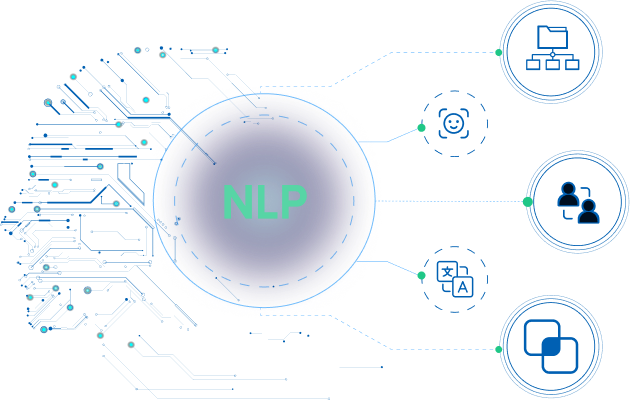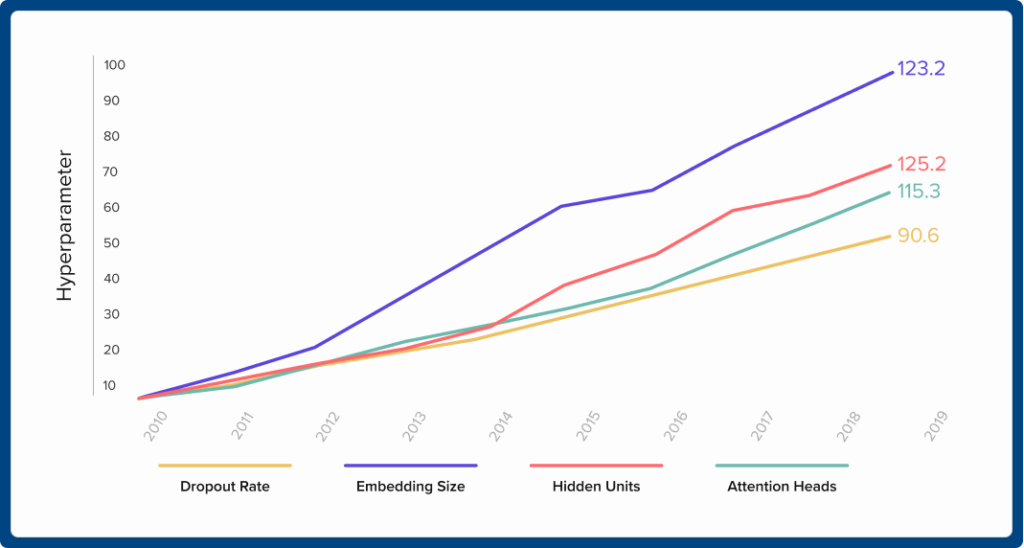Natural Language Processing
Grow your business with NLP and become a leader in your industry.

Natural Language Processing or NLP is a symbiosis of Artificial Intelligence and Linguistics. In other words, it is the process of computing and understanding human language through systems. NLP has already been fully implemented in our everyday life, and made every second of it easier. Find out how it works and what services will help you implement it.
Natural Language Processing
Managing Human-Computer Dialog System
Natural Language Classifier
Natural Language Generation
Machine Perception
Natural Language Understanding
Top 11 NLP
Tokenization
Stop Words Removal
Topic Modeling
Sentiment
Analysis
Named Entity Recogmition
Stemming & Lemmatization
Text
Summarization
Keyword Extraction
Term
Frequency
in NLP
Machine Translation
Word
Embedding
Amazinum’s data scientists will develop a solution for you that will fulfill your demands, save you resources, and improve customer service and profits. We develop our NLP expertise in the following services:
Tasks of NLP
Depending on the needs and goals, there are quite a lot of tasks in the NLP pipeline, but we will consider only the most common ones.
Automatic Speech Recognition or ASR
One of the most popular NLP tasks that involves the reliable transformation of voice data into full-fledged text. The real challenge for systems is the peculiarities and individuality of human speech – the vagueness, accent, intonation, speed, and stresses – all of these are of great importance for text processing. However, human speech recognition tools have a fairly low rate of word error.
Text classification
In this case, the system faces the task of assigning a category or class to a certain fragment of text entered in natural language. Machine Learning Algorithms divide voluminous fragments of documents or text data into categories, which allows to optimize work processes. Such classification has many applications, including filtering spam or analyzing medical devices.
Word Disambiguation (WSD)
Using semantic analysis, polysemous words are reduced to the meaning that makes the most sense in the given context. The software helps to disambiguate texts and distinguish between their meanings. Here Machine Learning algorithms are used to improve context identification.
Text-to-speech (TTS)
The opposite task of ASR is converting text to audio. Then the task of NLP is to process audio information and give it in human language. Such software is widely used in visual aids and makes the product or content more inclusive. This allows people with disabilities to use certain services.
Topic modeling
The main purpose of segmentation is to extract key topics from a document. The system analyzes various linguistic features, such as repeated references to the topic or events, the use of certain phrases of the language to create a connection between ideas, repetition of vocabulary, etc. Each of these aspects is measured to build a thematic model, which in turn is built using Machine Learning or Statistical methods. At the same time, the complexity of such a model already depends on the information available for it.
Sentiment analysis
The analysis of opinions, also called the analysis of thoughts or emotions, is aimed at understanding the emotional tone of the text. With the help of NLP algorithms, opinions are assigned to certain words, based on the lexical series with which they are associated. The model classifies text based on emotions and even intentions. In this way, the system can analyze whether it has a complaint, a request, or an opinion. The use of such a service is reduced even to reviews of products in the supermarket, not to mention the widespread use in the marketing field to assess the level of sales and customer interest.
Large Language Model
The Large Language Model (LLM) is an NLP-based Artificial Intelligence algorithm that uses deep learning methods and huge data sets. It makes it possible to understand, generalize, generate, and predict new content. LLMs can be called an evolution in the concept of a language model. Their goal is to generate a text, the context of which is related to the input. They use patterns from information that they have seen to provide new content based on the text input.

How do large language models work?
How it works

In general, working with LLM requires a complete approach consisting of several components:
LLMs are trained on a large volume of data – a corpus — of data that is typically petabytes of raw text in size. Model training, in turn, can also consist of several stages. The first step will be training on unstructured and unlabeled data. The model begins to derive connections between different words and concepts.
The next stage is the improvement and training of the model, with the help of forms of self-control. At the same time, data labeling helps the model more accurately identify different concepts.
The models are based on transformer architecture, which comes in two parts – encoder and decoder. The encoder transforms raw input into some meaningful computer information (some concepts), while the decoder transforms new information generated from the encoder back into human-readable output. They use a mechanism called self-attention. This mechanism finds the relationship between words and grasps the concepts behind them and their importance. Then this information could be used to create new meaningful information.
After completing the LLM training, it can be used for practical purposes. LLMs can generate a response that can be an answer to a question, a newly created piece of text, a short piece of text a sentiment analysis report, and many more solutions.
LLM Models Training
Data Gathering
1
Data Cleaning
2
Data Splitting
3
Model Set-up
4
Model Training
5
Model Checking
6
Model Usability
7
Model Enhancement
8
What are large language models used for?
Due to their broad applicability for a variety of NLP tasks, such as the following, LLMs have grown in popularity:
Text generation
One main use case is that the LLM can produce text on any subject that it has been trained on.
Content summary
Summarizing sections or entire pages of text is one of LLMs’ useful functions.
Classification and categorization
Content can be categorized and classified by an LLM.
Rewriting content
There is also the ability to rewrite a passage.
Translation
The capacity to translate between languages is a common trait for LLMs who have received multilingual training.
Conversational AI and chatbots
Compared to earlier generations of AI technologies, LLMs can facilitate a conversation with a user in a way that is usually more natural.
Sentiment analysis
The majority of LLMs can be utilized for sentiment analysis, which aids users in comprehending the meaning behind a given response or piece of content.
Text classification
LLMs can categorize text with comparable sentiments or meanings by using clustering. Measurements of customer sentiment, text correlation analysis, and document search are among the applications.
Code generation
LLM are skilled at creating code based on prompts in natural language. Examples are the Open AI codex used in GitHub Copilot and Amazon CodeWhisperer, which can code in Python, JavaScript, Ruby, and a number of other programming languages. Writing shell commands, building SQL queries, and designing websites are some additional coding applications.
Business value of LLM
LLM Use Case Categories
Data Transformations
A data product that transforms a text input into a text output, e.g. classify, summarize, convert to JSON
Copilots & Assistants
A mixture of natural language interfaces and automation capabilities, used in the loop with a human user, e.g. Microsoft Copilot
Workflow Automations
Automate predefined workflows using access to data and tools, e.g. write a proposal, book a flight
Natural Language Interfaces
A language based interface to data or a tool, e.g. chat-your-documents, sql query
Autonomous Agents
Automate arbitrary, unseen workflows using data and tools
LLMs offer a multitude of benefits to both users and organizations.
- Flexibility and versatility
Personalized use cases can be built upon LLMs. Adding more training to an LLM can help create a customized model that meets the unique requirements of an organization. - Adaptability
One LLM can be used for a wide range of deployments and tasks for users, organizations, and applications. - Activity
Most contemporary LLMs are high-performing and capable of producing quick, low-latency responses. - Precision
The transformer model can produce ever-higher levels of accuracy in an LLM as the volume of trained data and the number of parameters increase. - Easy to learn
Unlabeled data is used to train a large number of LLMs, which speeds up the training process.
NLP and Business Solution
Economy and commercial industries
It doesn’t matter in which specific branch of the economy you work, NLP will help you improve your service because thanks to it you will be able to automate the mechanisms of proposals or recommendations, set up machine translation and sentiment analysis, and much more.
Healthcare sector
Owing to the use of Natural Language Processing, the system, using computer coding, can segment long medical records, reducing them to the most important points. Together with the use of NLP, a simplified EHR interface was created that automates the search for information about patients’ doctor appointments. Using NLP, analysts have gained access to vast amounts of patient data information to classify them by phenotypes and groups.
NLP in Finance
In the field of finance, it is important to be accurate and on time, so NLP is exactly what will provide you with these functions. Increase data with the help of a virtual assistant or chatbot, which helps to save financial resources and increase comfort, structure appeals and complaints to the right department and timely and qualitatively answer basic questions.
NLP for the Legal Field
If you are the owner of a legal business, the Amazinum team knows how to make it even more successful and customer-oriented. For this, you need to trust us and the potential of NLP. You will automate the processing of legal documents. NLP gets contract names, key names, and required data, and can even make the document anonymous.
NLP for Business
Any business requires always promptness, so the Amazinum team has a brilliant solution for you – NLP. You will be able to easily extract key information from unstructured documents that usually come in the scanned form and much more.
NLP has already been fully implemented in our everyday life, and every second it is made easier. Nevertheless, they still create a huge potential for optimizing your business or product. You can automate routine processes, direct your resources toward ideas and creativity, transform your business, make it convenient for the client, and create high-quality content and analytics on various issues.
NLP creates a huge potential for optimizing your business or product. You can automate routine processes, direct your resources toward ideas and creativity, transform your business, make it convenient for the client, and create high-quality content and analytics on various issues.
Trust Amazinum Data Scientists and then your clients can easily trust you.
The Business Value of NLP
Implementing NLP in your business can help you achieve many business goals. This can affect customer engagement, operational efficiency, and overall business potential.
Here are some of the results you might get:
- Increase your interaction with the client due to instant and personalized responses
NLP will enable you to understand human language, identify terms, tone and context in interactions, and it can also provide you with the knowledge you need to respond meaningfully and accurately. This will increase customer satisfaction and promote positive brand perception. In addition, NLP will allow you to respond to customers around the clock, and offer them support regardless of working hours. - Save your money
Automate routine tasks, allocate resources efficiently, and reduce the need for additional staff. All this is thanks to the implementation of NLP. - Optimization of work
NLP excels at automating repetitive tasks. Free up human resources for more complex tasks, and entrust routine tasks to Artificial Intelligence. - Get information from documents such as reports, contracts, securities, etc. The classification of documents and their use will help you make your business more efficient and get the desired result. NLP will help you understand volumes of data, extract information from them, simplify jargon and technical explanations, and understand the essence of documentation.
Applications of Natural Language Processing
Language Translation
Social Media Monitoring
Automatic Summarization
Document Analysis
Online Searches
Sentiment Analysis
Predictive Text
Chatbots
Email Filtering
Smart Assistant
Companies that already use NLP
Large and successful companies have long been using NLP to improve their business and make it more efficient.
Dropbox
Application: By comprehending natural language queries, Dropbox integrates NLP for content organization, document search, and enhanced collaboration.
Zoom
Use: Zoom leverages natural language processing (NLP) to improve the functionality of its video conferencing platform and to provide features like automatic transcription.
TikTok
TikTok uses natural language processing (NLP) to curate personalized content feeds, understand user language during user interactions, and recommend content.
Samsung
Use of natural language commands to control and communicate with Samsung devices is made possible by Samsung’s integration of natural language processing (NLP) into its virtual assistant Bixby.
Tradeshift
Application: Tradeshift’s supply chain and procurement platform leverages natural language processing (NLP), allowing companies to comprehend and handle requests in natural language used in procurement workflows.
Adobe Sensei
Use: Adobe’s AI platform, Adobe Sensei, incorporates natural language processing (NLP) to improve a range of creative and marketing tools, as well as for content analysis and image recognition.
Application: To improve user engagement on its professional networking platform, LinkedIn employs natural language processing (NLP) to deliver personalized content and make job recommendations.
Hootsuite
Application: Hootsuite makes use of natural language processing (NLP) to analyze sentiment, measure social media content effectiveness, and perform social media analytics.
Salesforce
Use: For tasks like sentiment analysis, customer support, and comprehending customer interactions, Salesforce incorporates natural language processing (NLP) into its CRM platform.
Ahrefs
Utilizing natural language processing (NLP), Ahrefs is an SEO tool that analyzes content, finds keywords, and offers suggestions for improving website content.
Grammarly
Application: Grammarly checks written content for grammar errors, suggests styles, and improves language using natural language processing (NLP).
FAQ
Which tools and services can be used for NLP?
Gensim, SpaCy, IBM Watson, Natural Language Toolkit (NLTK), MonkeyLearn, TextBlob, Stanford Core NLP, and Google Cloud Natural Language API.
What are the 4 types of NLP?
One of the most significant computer science techniques is natural language processing, or NLP, which is essential to many fascinating applications like artificial intelligence (AI) and chatbots. Statistical techniques, stochastic techniques, rule-based techniques, and hybrid techniques are the four categories of techniques.
What is NLP with example?
Artificial Intelligence (AI) has a subfield called Natural Language Processing (NLP). It facilitates the processing and comprehension of human language by machines, enabling them to carry out repetitive tasks automatically. Machine translation, summarization, ticket classification, and spell checking are a few examples.
Amazinum Portfolio
The Amazinum team developed NLP solutions for various business sectors.
Check out our NLP projects to see how implementing solutions can make your life easier.
Artificial Intelligence & Machine Learning for SEO & Content Management Software

Our Industry Focus
Our industry knowledge and background give our clients and partners confidence that we understand their business. Here we highlighted a few top industries we are good at, penetrating to the smallest details and nuances of a certain branch.
SEO & Marketing
Healthcare
Safety & Security
Sport
E-commerce & Retail
Gambling and Casino
Manufacture
Ecology
FinTech
Energy
Localisation
IoT
Partners & Clients
We deeply appreciate our partners for cooperation. Every member of the Amazinum Team does their best to provide the highest quality of services and solutions. We satisfy all your needs and requirements.
Technologies
Learn about technology stack we use to implement data science:
Programming languages:

for data analysis and processing:
for creating solutions:
for API development:
for visualization:
Deploying solutions:





Databases:
SQL:
NoSQL:
Cloud Solutions:


Vitaliy Fedorovych
CEO, Data Scientist at Amazinum

Hello there!
Amazinum Team assists you through all data science development processes:
from data collection to valuable insights generation.
Get in touch with our CEO and Data Scientist to figure out the next move together
- 4A Peremohy square, Ternopil, Ukraine, 46000
- +380 98 85 86 330
- vfedorovych@amazinum.com
Contact Us

Bazarnitska Alina
Client Partner

Ihor Khreptyk
Client Partner

Stopnyk Zoriana
Client Partner

Vitaliy Fedorovych
CEO, Data Scientist
